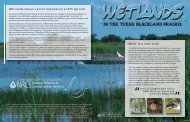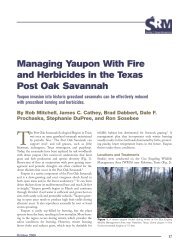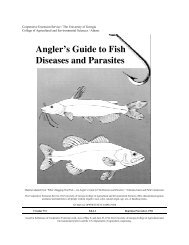Texas Farm Ponds: Stocking, Assessment, and Management ...
Texas Farm Ponds: Stocking, Assessment, and Management ...
Texas Farm Ponds: Stocking, Assessment, and Management ...
Create successful ePaper yourself
Turn your PDF publications into a flip-book with our unique Google optimized e-Paper software.
ponds with only those species. The presence of<br />
these species in a pond with an adequate bluegill<br />
population, however, poses little threat to bass<br />
populations.<br />
Crappie also compete with largemouth bass for<br />
forage, <strong>and</strong> their high reproductive rate may create<br />
stunted, starving crappie populations in small<br />
impoundments.<br />
Other undesirables, regardless of the size of the<br />
pond, include black or yellow bullhead, common<br />
carp, carpsucker, buffalo, <strong>and</strong> Rio Gr<strong>and</strong>e cichlid.<br />
These species compete with desirable species for<br />
food <strong>and</strong> space. Several of these species can create<br />
muddy conditions in ponds.<br />
In ponds managed for catfish only, any predator<br />
capable of feeding on catfish (such as largemouth<br />
bass, gar, or flathead catfish) should be avoided.<br />
Likewise, species that compete with the catfish for<br />
food (like green sunfish, golden shiners, <strong>and</strong> black or<br />
yellow bullheads) are undesirable.<br />
Bass-Bluegill Population Structure. After you<br />
have determined which species are present, seine to<br />
determine the presence or absence of bass <strong>and</strong><br />
bluegill reproduction. These two species provide the<br />
basis for predator-prey relationships in <strong>Texas</strong> farm<br />
ponds. The seine is the best method for gathering<br />
information on overall pond balance. Use Table 3 to<br />
evaluate the data collected by the quadrant seine<br />
haul technique. The presence or absence of bass <strong>and</strong><br />
bluegill reproduction should almost always provide<br />
the information required for pond management<br />
decisions. Supplement this information with angler<br />
catch records whenever possible to provide<br />
information on the sizes of adult sport species in the<br />
pond. Some pond owners can use accurate records<br />
of numbers <strong>and</strong> sizes of fish caught by anglers for<br />
more in-depth assessment <strong>and</strong> management. A<br />
detailed description of the methods is contained in<br />
the Appendix.<br />
Catfish Population Structure. Since shoreline<br />
seining will not provide much information on<br />
catfish, base your assessment of catfish populations<br />
on catch records <strong>and</strong> the general condition of the fish<br />
caught. Although these techniques apply<br />
specifically to catfish-only ponds, they can be useful<br />
for catfish assessment in multi-species ponds as<br />
well. At appropriate stocking rates (see Table 1),<br />
survival of stocked catfish will approach 100<br />
percent. Knowing how may catfish have been<br />
removed will allow you to calculate how many<br />
remain in the pond. Under no circumstances should<br />
the total weight of catfish exceed 1,000 pounds per<br />
surface acre during the warm months.<br />
Although some pond owners do not regularly<br />
feed their catfish, occasional feeding (at intervals of<br />
1 to 3 weeks) with floating pellets allows you to<br />
determine whether the population has declined. If<br />
the number of catfish coming to feed drops markedly<br />
<strong>and</strong> remains low even in a variety of weather<br />
conditions, the population has probably been<br />
reduced by disease or v<strong>and</strong>alism. When you collect<br />
the catfish for population assessment, also make note<br />
of their body condition (plumpness). Since a<br />
distended gut can be misleading when you are<br />
making visual appraisals, concentrate on the<br />
thickness of the flesh when you observe the fish<br />
from above. If the catfish are overstocked <strong>and</strong>/or the<br />
food supply is insufficient, the fish will become<br />
“skinnier” over time. This sometimes happens if<br />
unexpected natural spawning occurs. In contrast, as<br />
the fish population declines because of fishing (or<br />
other mortality), the flesh will become thicker <strong>and</strong><br />
“fatter.”<br />
Corrective <strong>Management</strong><br />
Three techniques can be used for correcting<br />
unbalanced or undesirable fish populations:<br />
renovation, harvest manipulation, <strong>and</strong> supplemental<br />
stocking. However, if unsatisfactory fish<br />
populations are the result of poor water quality,<br />
improper pond design, or an overabundance of<br />
aquatic vegetation, these techniques used alone may<br />
not be successful.<br />
Renovation. Consider total renovation using<br />
rotenone if species such as gar, bowfin, flathead<br />
catfish, chain pickerel, black bullhead, common<br />
carp, buffalo, <strong>and</strong> carpsucker are present. If crappie<br />
are present, stunting (poor growth) <strong>and</strong><br />
overpopulation can sometimes occur, <strong>and</strong> renovation<br />
may be necessary. The presence of warmouth <strong>and</strong><br />
green sunfish does not require renovation if bluegill<br />
are present or can be supplementally stocked.<br />
Harvest Manipulation. Angler harvest is an<br />
important management tool for adjusting the<br />
population structure of sport species. For bass <strong>and</strong><br />
bluegill ponds, harvest recommendations are<br />
determined by the relative abundance of the two<br />
species <strong>and</strong> their size distributions (Tables 3 <strong>and</strong> 4<br />
on next page). Harvest recommendations for<br />
balanced bass-bluegill populations are given in the<br />
Proper Harvest section.<br />
18









